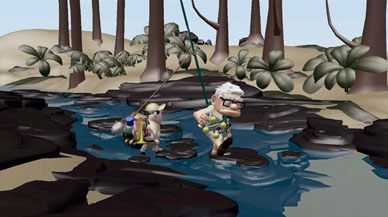Hollywood Psych
By Sean Collier
May 29, 2009
BoxOfficeProphets.com

This year, Pixar enters the burgeoning market of mainstream 3-D releases. Surprisingly, it was the Mouse House itself that led the way with this technology, not Pixar. 2005's Chicken Little was the first to utilize the new Real D technology, followed by a number of other Disney releases, including Meet the Robinsons and Bolt. The success of the new format has led both Disney/Pixar and chief rival DreamWorks to announce that all of their animated features will henceforth be released in 3-D.
This is a surprising turn for a gimmick once thought dead, relegated to theme parks and comic books in the '90s. However, a sharp distinction lies between the new resurgence of 3-D film and the scattered examples of the technology throughout history. While these films are being released in 3-D, they are also being released in normal, "flat" prints. Seeing these films in 3-D is an option, not the point.
This has made more sense with certain Real D releases than others. Robert Zemeckis' bizarre CGI retelling of Beowulf made good use of the 3-D technology, but was essentially unchanged (and just as mediocre) without the glasses; by contrast, this year's My Bloody Valentine 3D was little more than a thrown-together excuse to show some blood and nudity in three eye-popping, cringe-inducing dimensions.
One gets the impression that most of the films being released with this technology – certainly Pixar and DreamWorks films, if not all the Real D efforts – would still have been greenlit without the gimmick attached. Pixar's late arrival to the party seconds this – Real D is not true, game-changing innovation. If it were, Pixar would have been on top of it long ago. Up is in no way about exploring the possibilities of Real D; I saw a screening of the flat version of the film, and the film did not suffer a bit without the glasses. If you had never told me that a 3-D version of the film existed, I never would've guessed.
The reasoning behind the proliferation of Real D films is actually far more base than one might think. Since the '80s and '90s homogenized nearly every movie theater in America into identical multiplexes, distributors and theater owners have been searching for ways to make the movie-going experience unique – and, thus, charge more for admission. The late-'90s introduction of stadium seating was the first stab at this "added value" system; quickly, all new multiplexes were built with stadium seating alone. Naturally, these super-multiplexes quickly introduced premium seating – if you've never been, these are basically easy chairs in the theater, with the best views and other minor amenities.
One can only dress up a movie chair and jack up the price so much, however, and distributors were only too happy to begin providing advanced technology to encourage exhibitor gouging. IMAX has not only convinced us we need to pay more for a bigger and better screen, they've actually begun convincing us to pay for the brand alone. A recent pseudo-controversy, sparked by blog posts from actor Aziz Ansari, surrounded IMAX's new policy of slapping the brand name on screens that aren't that much bigger than normal movie screens, even though this all but negates the advantages of IMAX projection. Still, the distinction of these exhibitions over normal showings – whether that distinction is significant or minor – gives theaters a reason to charge more for certain showings, and to this point, we seem to be willing to pay it.
The same goes for Real D. Is much lost by seeing Coraline, Monsters vs. Aliens, Up, or (god forbid) The Jonas Brothers in two dimensions? Not particularly. These films are made for their own purposes, not as a diversion from actual cinema. However, it's a distinction over the presentation at any old theater, and exhibitors love added value; judging by ticket sales and the public's willingness to pay up to 50% more per ticket for Real D and IMAX, it seems that fans love these enhancements as well.
You'll forgive me for being jaded in the face of technology, but this too shall pass. IMAX and Real D are not the future of film, they're just the current trend in exhibition. I'd be utterly surprised if every film was shown on a Real D IMAX screen 40 years from now; I wouldn't be shocked at all if these technologies swiftly went the way of the drive-in.
Come to think of it, I still like the drive-in more than IMAX.